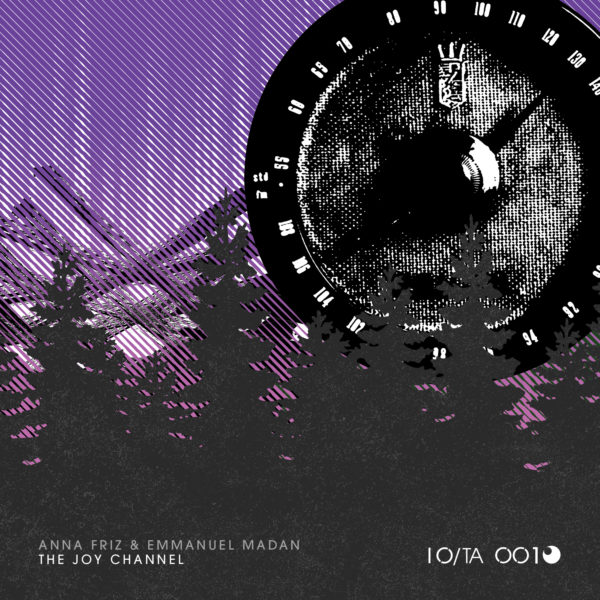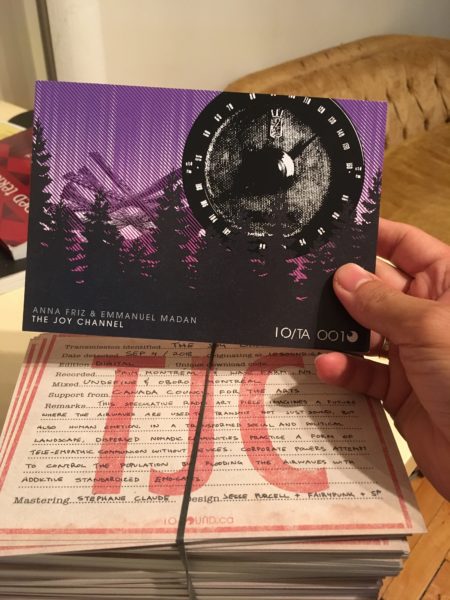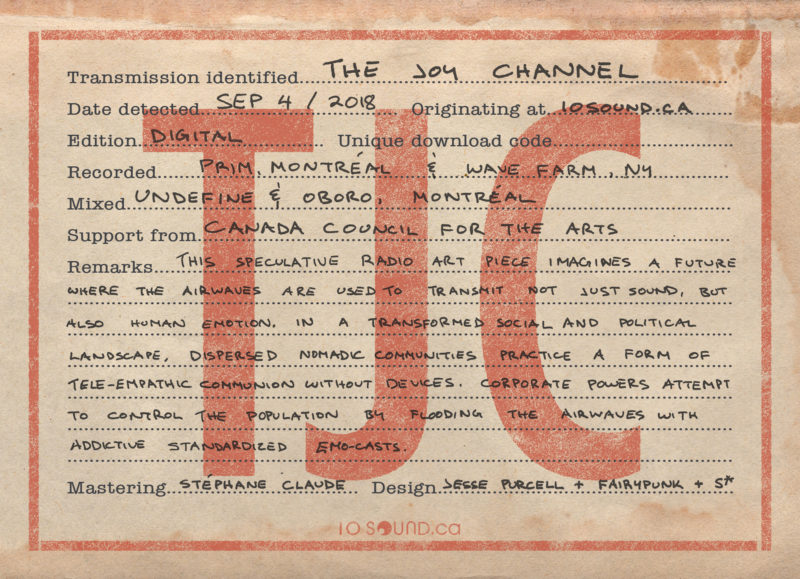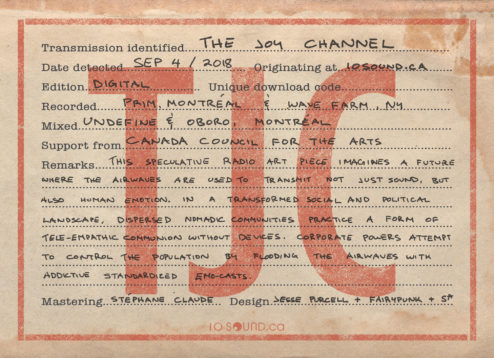 ANNA FRIZ & EMMANUEL MADAN
ANNA FRIZ & EMMANUEL MADAN
THE JOY CHANNEL
Digital Release
This speculative radio art piece imagines a future where the airwaves are used to transmit not just sound but also human emotion. In a transformed social and political and landscape, dispersed nomadic communities practice a form of tele-empathic communion without devices. Corporate powers attempt to control the population by flooding the airwaves with addictive standardized emo-casts.
— Anna Friz & Emmanuel Madan
The Joy Channel is the first release of the IO/TA sublabel dedicated to the Transmission Arts (TA). Exploring the obscure yet omnipresent airwaves of radio, broadcast, and transmission arts, IO/TA seeks to release works that blur the lines between music and abstraction, narrative and the imaginary. The transmission arts combine aspects of broadcast aesthetics, storytelling, and recording and distribution technologies into integral elements of the aural object, reminding us that sound is not a transparent thing but that it comes from somewhere to the inner (h)ear.
— tobias c. van Veen
The Joy Channel
created and produced by Anna Friz and Emmanuel Madan
Over a century from now, business as usual has rendered the nation states of Canada, the United States and Mexico extinct. Approximately 40 million people remain in New North America who are mainly concentrated on the west and east coasts in city-states such as Van and Turnpike, or in the walled-in corporate state strongholds of Fortress Alaska and the Protectorate of Utah. Inland, sparse but emergent communities persist.
In this future, the radio ecology still includes community radio, CB and ham radio as technologies which have survived the social and environmental cataclysms by being relatively easy to salvage, fix, and modify, and therefore remain useful to improvised new societies that tend towards local systems, nomadism and scavenging. But radio in the future is not only a sonic medium: it also becomes a means of transmitting neural information in the form of standardized human emotions (corporate ’emo-casting’), or for tele-empathic communion without devices practiced by dispersed nomadic communities.
We tune across the territories of the future radio to learn of the transforming geopolitics and the emerging EM (empathy modulation) band, from the transmissions of a lone ham radio operator or ‘wavefinder’ to the ongoing conversations of a group of hams radioing across the continent, to corporate shills, pundits, religious figures, the seductive sounds of emocast channels, and among them, something new being felt across the spectrum.
This speculative radio art piece explores tensions between the neurological manipulation of emotions and empathic realization, the interaction between the listeners as active or passive subjects, and the renewed struggle over access to the airwaves.
The Joy Channel was originally commissioned by Radio Tesla, Berlin for RadioVisionen: 250 Jahre Radio in 2007. This release is a completely new version of the work with a new script, characters, and scenario, and was chosen as a finalist for the Phonurgia Nova Awards in 2017.
credits
releases September 4, 2018
Produced: /Undefine, Montréal
Recorded : PRIM, Montréal
Mastered: Stéphane Claude, Oboro, Montréal
Design: Jesse Purcell + Fairypunk + s*
Production Assistance:
Canada Council for the Arts
ORF Kunstradio (Vienna)
Wave Farm, Acra NY
Künstlerhaus Bethanien (Berlin)
PRIM (Montréal)
Oboro (Montréal)
Voices: Sarita Ahooja, Leslie Baker, Alexis Bhagat, Matt Bua, Brian Dewan, Lorrie Edmonds, Danielle Frank, Anna Friz, Gina Grotelueschen, Justin Grotelueschen, Darsha Hannah Hewitt, Ricardo Lira, Emmanuel Madan, Randy Peters, Tom Roe, Victoria Stanton, Vince Tinguely, Rufo Valencia
Special thanks to Galen Joseph-Hunter and Tom Roe (Wave Farm), Stéphane Claude and Claudine Hubert (Oboro), Steve Bates (Hexagram), and tobias c. van Veen (IO SOUND).
Thanks to all those involved with earlier incarnations of this work, especially Martina Groß, Andreas Hagelüken, Séamus O’Donell, Moritz von Rappard and Johannes Wilms (Radio Tesla, 2007) and Elisabeth Zimmermann (ORF Kunstradio, 2009).







